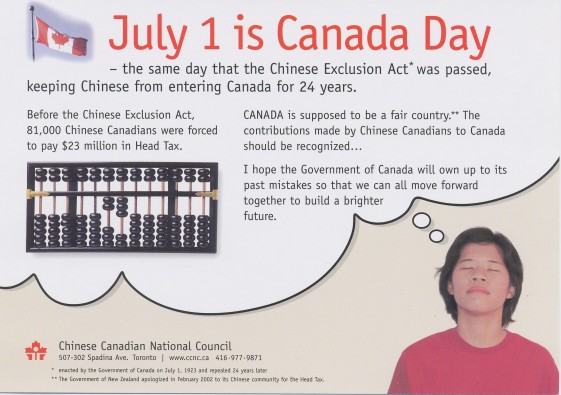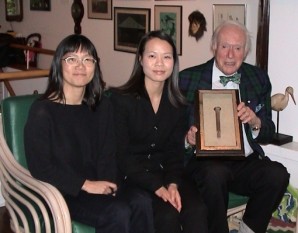Redress door left open
Justice Cumming, despite ruling against the class action, nonetheless included the following statement in his judgment on Mack v. Canada, delivered on July 9, 2001:
“These findings must not be taken as an acceptance of the actions of Canadian governments in creating and implementing the various forms of the Chinese Immigration Act. Quite clearly, these Acts, if enacted today, could not withstand Charter scrutiny. The legislation in its various forms was patently discriminatory against persons of Chinese origin. By contemporary Canadian morals and values, these pieces of legislation were both repugnant and reprehensible. The Chinese Immigration Act, 1885, and its successors have come to symbolize a period of Canadian history scarred by racial intolerance and prejudice.”
He also expressed the opinion that “it may very well be that Parliament should consider providing redress for Chinese Canadians who paid the Head Tax or were adversely affected by the various Chinese Immigration Acts . . . I do not quarrel with the plaintiffs’ basic submission that merely repealing a discriminatory law, without repairing its discriminatory effects, does not necessarily effectuate substantive equality for the disadvantaged group nor redress the negative effects of discriminatory treatment.”
Clearly the only recourse for Chinese Canadians on the Road to Justice was to reach a political solution to redress the decades of official discrimination.
Last Spike Campaign
In 2003, the late Canadian historian Pierre Berton gave a ceremonial iron railway spike to redress activists who toured the historical icon around the country as part of the “Last Spike Campaign”, rebuilding support for a public demand for redress.
Two years later, octogenarian Gim Wong, a World War II veteran whose father paid the head tax, rode his motorcycle from Vancouver to Parliament Hill, where then Prime Minister Paul Martin refused to meet him.
CCNC v. NCCC
In 2005, Prime Minister Paul Martin, following the advice of his junior minister for Asia and Pacific affairs, Raymond Chan (Richmond), decided to try to reach a deal with a Chinese Canadian group other than CCNC. This was the National Congress of Chinese Canadians (NCCC), an organization formed in the early 1990’s. NCCC leaders met with officials to hammer out an agreement based on “no apology and no individual compensation,” although the government agreed to pay the Congress $2.5 million to set up a Chinese Canadian Community Foundation.
CCNC was hamstrung after being frozen out of talks with Martin’s Liberal government, but continued to push for the issue. Other community groups, including the B.C. Coalition of Head Tax Payers and the Ontario Coalition of Chinese Head Tax Payers and Families joined in and remobilized the community for a fight.
At the same time, a private member’s bill was introduced by Tory MP Inky Mark (Dauphin-Sawn River-Marguette) to the Standing Committee on Heritage. Bill C-333, the Chinese Canadian Recognition and Redress Act, sought to acknowledge, commemorate and educate about past government wrongs – falling far short of the apology demanded by generations of Chinese Canadians.
Further amendments (see document Bill C-333) agreed by the committee (supported by both the Liberal and the Conservative Parties) at its meeting on Nov. 3, 2005, included the following clause:
“1.1 The Government of Canada shall undertake negotiations with the National Congress of Chinese Canadians towards an agreement concerning measures that may be taken to recognize the imposition of exclusionary measures on immigrants of Chinese origin from 1885 to 1947.”
The amended clause eliminated CCNC, and its representation by proxy of more than 4,000 head tax payers, their spouses and families, from any settlement talks with the government.
Perfect political storm
The power struggle between the Liberals and the Conservatives created an opportune moment for redress activists when on Nov. 24, 2005, Martin’s government lost the confidence of the House of Commons, forcing the dissolution of Parliament and a general election on Jan. 3, 2006.
Members of the Ontario Coalition of Head Tax Payers and Families lobbied senior members of the Conservative Party to stop Bill C-333 from being passed. The Conservatives, who were eager to make inroads into Canada’s “ethnic communities”, exercised a procedural prerogative and switched the order of Bill C-333 with Bill C-331, a bill to recognize past wrongs against Ukrainian Canadians during wartime. The result was that the latter bill was passed, while C-333 died on the order paper.
During a pre-election interview with Fairchild Chinese Radio in December 2005, Tory leader Harper promised to provide individual compensation for the direct victims of the Head Tax if his party were elected to government.
A revitalized CCNC, with assistance from the B.C. and Ontario Coalitions, mobilized Chinese Canadians, and together they raised the electoral profile of the community, leveraging its political clout in ridings across Canada. The 2006 federal election campaign energized a new generation of Chinese Canadian activists, and encouraged many long-time community participants to renew their involvement in the redress issue. For the first time, much of the support for redress came from Chinese Canadians who were more recent immigrants, but who also identified with the journey earlier Chinese had taken on the Road to Justice.










